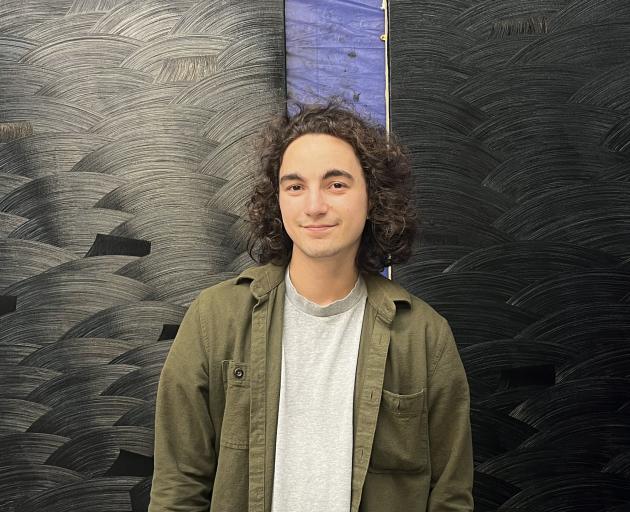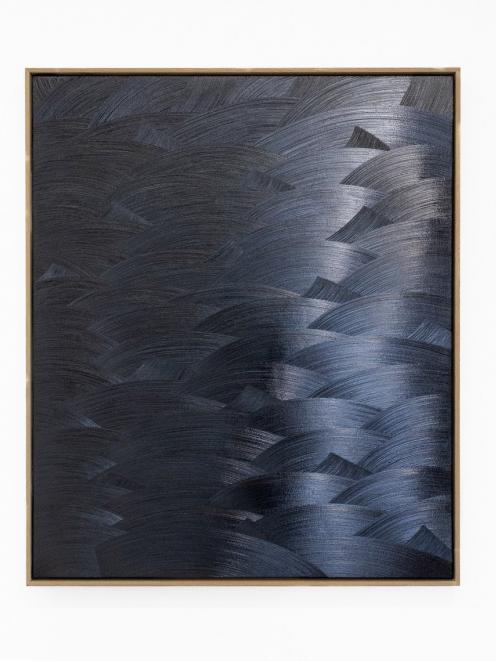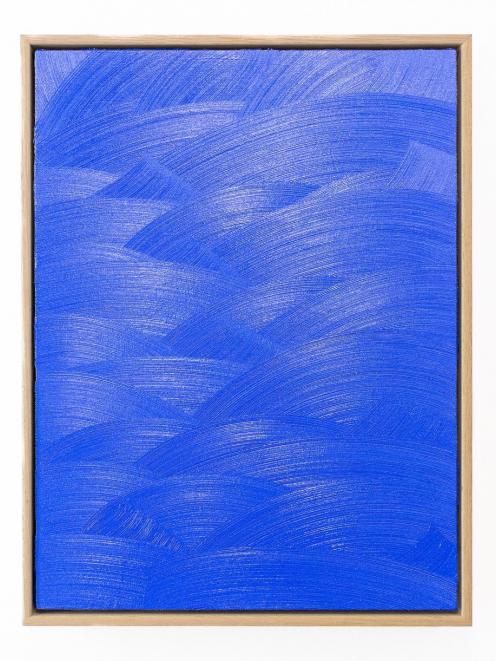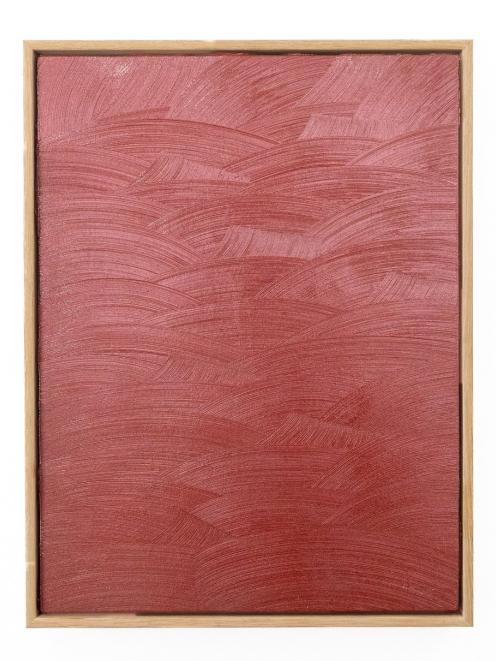
Being told he was not a good painter and never could be, as he lacked fundamental drawing skills, just nudged Jamie Te Heuheu to work harder.
"It made me more interested in it, to learn a bit more."
The challenges of that first year studying at the University of Canterbury School of Fine Arts soon disappeared as Te Heuheu’s determination to follow his love of painting saw him graduate with a first class honours in 2020 and just two years later have his first solo exhibition "In a Sentimental Mood" at Hamish McKay Gallery in Wellington.
"It is amazing, sublime. I’ve been incredibly fortunate."
Considering his early success, Te Heuheu (Ngāti Tūwharetoa) came to art quite late only discovering it by chance when he changed schools for his last year of secondary school.
"There were a few clashes which saw me focus on art rather than science-based courses and I had a really supportive art teacher who was really great and encouraged me to give it a go. The rest is history."
His focus has always been painting as he enjoys the process. He creates mostly large-scale monochrome abstract works concentrating on process and brushwork.
"It’s fun."
His work is still developing, he admits. Like any young artist, it is easy to get your head turned by artists of the past.
"Being influenced by so many things around you and all these artists can be quite overwhelming. Young artists, including myself, have a tendency to copy others."

"After a while it wasn’t working so I went straight to monochromatic paintings, just black, which was somewhat freeing. There were boundaries to push against I guess."
After a few years he began to introduce colour.
"Just playing around with different tones, colours and applied processes as a way to upskill and learn a bit more. That’s where the current work comes from."
It started with a small work featuring different tones of blue on top of each other.
"It looked like the ocean or water, it somehow influenced what I’m doing now. In my mind it’s my perfect painting, one I’d love to be able re-create but I can’t it’s so cool.
"The ebbs and flows of that painting probably translated into the earlier blue ones I’m working on now. That’s moved into different tones expressing different emotions."
In a review of Te Heuheu’s second exhibition "In a Sentimental Mood" at Hamish McKay Gallery, held last year, art historian Michael Moore-Jones described his "deep, rich colours like those here bring to mind Ralph Hotere’s numerous ‘black paintings’ in which thin lines (very often red) vibrate on a deep-dark ground; and it brings to mind too a series of red drawings Hotere did while in Europe, drawing on Malevich and Kandinsky’s art as he figured out what it meant to be a Māori artist and an activist with a love of the European abstract painting tradition. There’s McCahon here, too, in his paintings of the sixties as he turned monochrome".
Te Heuheu says he researched Hotere’s work, when looking at his own identity as a Maori artist or an artist that was Maori as well.
"I really like Ralph’s work and he was a big influence but I have moved on to this point of trying to move further away from these influences to put more of myself into the paintings."
Having those influences is not a bad thing though as New Zealand has world-class artists, he believes. Only a couple of weeks ago he was looking at a McCahon work which gave him some ideas.
"I’m influenced by many others as well. I think all artists derive from what went before them and it is what they bring that will take the audience forward.
"At the same time, I just make the work, I don’t accompany it."

"It feels right that size. I’m limited to the size of my studio but I like working on a larger scale as it feels quite freeing yet when I work on works a lot tighter I still have the mindset of being quite free."
The large size of his latest work, 2m high by 2.4m, for the Aotearoa Art Fair has meant he has had to rent space in his friend’s garage to create it.
"It’s pretty big."
He remained tight-lipped about any great meanings inside his works waiting to be unlocked by the viewer.
"I like to evoke different emotions and feelings in the viewer but I don’t want to control it, I want to leave enough room for the viewer to bring their own associations to the work."
Viewers can be steered in certain directions by textures, applied processes and colours in the work, but he does not want them to be force fed.
"I want people to trust their instincts and hope that is enough for them to get into a painting."
Lighting plays a big part in how his works are viewed and he enjoys seeing them under artificial light at night as well as natural light during the day.
"They’re very dynamic paintings — the colours will change with sunlight and different lighting and the movement of the work will change as well. It’s a nice surprise viewing the work at different times of the day."
Being exhibited at Hamish McKay Gallery and then Starkwhite (Queenstown-Auckland) was beyond his imagination as was having his first solo show in a gallery of that calibre at 24.
"The artists I’m associated with is really cool. My first solo was with Hamish McKay — you can’t do much better than that."
It has not all been by chance though, a lot came down to hard work, concentrating not only on the creative side of being an artist, but the business side as well. When he left university he helped set up The Den, an artist-run initiative in Christchurch with Sophie Ballantyne, Rupert Travis and Tessa McPhee which ran for a year until the end of 2021 with the aim of going the Auckland Art Fair.
"I loved it. It was incredibly fun and challenging. We got to support a lot of young artists, many of whom ended up in several private collections, and I was very fortunate to have networked quite a bit before we started."
Not many people realise that sometimes being an artist is not just about "this burning passion. It is a lot of hard work".
"There is the art making and the art business and they are completely different things. It’s pretty tricky."
He had offers of solo shows prior to Hamish McKay but waited until the right one came along.
"I’ve been quite calculated about it. You are essentially running a business to a degree. You have to take risks and it is important to say no. You don’t want to be on this treadmill gaining no traction."
For Te Heuheu coming up with his own idea of what success meant to him was important.
"That helped out quite a lot."
Then contemporary art gallery Starkwhite, who also represents the likes of photographer Fiona Pardington and artists Martin Basher and Billy Apple, offered to represent him.
"It was somewhat intimidating — I’m the youngest artist by quite a lot. The last artist they signed up was Bill Henson (Australian photographer) four years ago and my solo was alongside Bill — that’s like pretty fantastic."

"I had a game plan written up a few different ways and I probably didn’t see it getting to this point so quickly. I probably have a couple of [the] best galleries in the country. It’s pretty surreal and pretty damn cool."
Alongside the success comes pressure, most of it he puts on himself, Te Heuheu admits.
"When you look at the stable these galleries have, there is probably a lot of pressure I’m putting on myself but at the same time — if you want to run with the bulls ... you have to be prepared for it.
"I’m aware I’m so young I need to make the most of these opportunities. I need to hold up my end of the relationship."
But he feels confident the galleries are aware that he is still in the early stages of his career and experimenting to see where his work takes him.
"They are supportive of that."
He is also working a fulltime job in database management at Canterbury Museum and while his managers are supportive of his art practice, it means finishing work and then hitting the studio, which at present is in his garage, and working until midnight.
"It’s quite challenging. You work around it and try and do the best work you can do."
That often means when he is "in the zone" he likes to continue until it’s perfect.
"It results in some very long painting sessions."
Having finished his art fair work, he is now looking to take a "breather" and find a better studio space.
Ultimately, he would like to paint fulltime.
"That would be the goal but I need to find a studio first."
To see
Jamie Te Heuheu, Aotearoa Art Fair, Auckland, April 18-21; Starkwhite Gallery Queenstown; "That Old Feeling", Hamish McKay Gallery, Wellington, until April 13.












